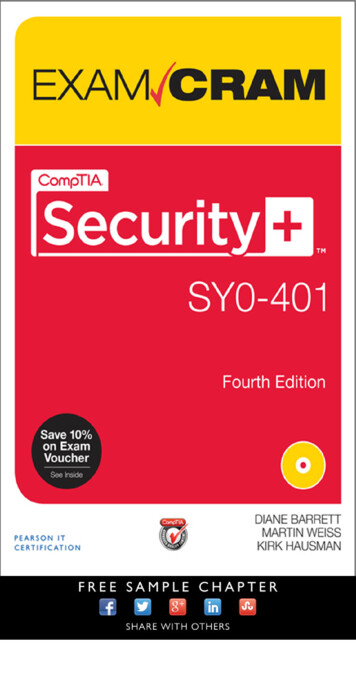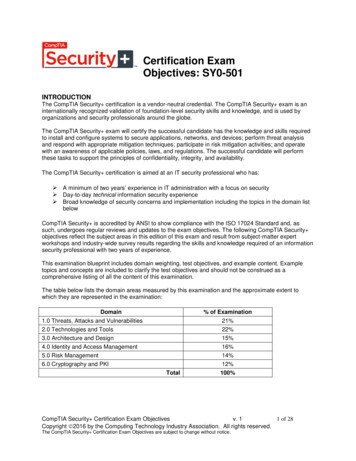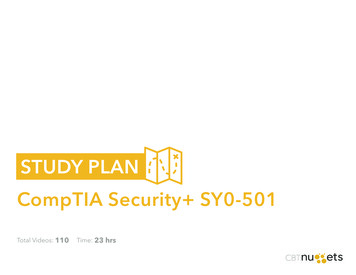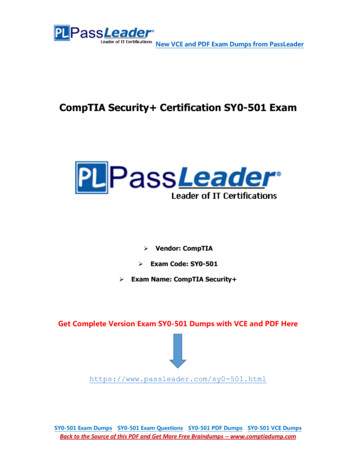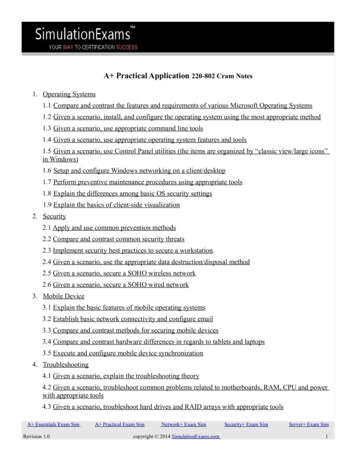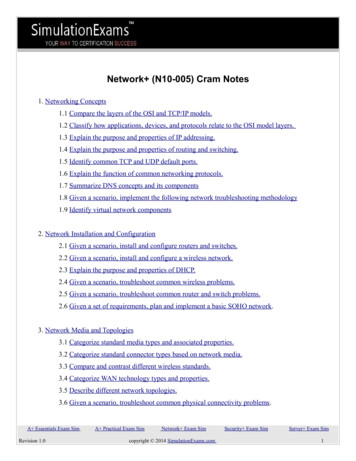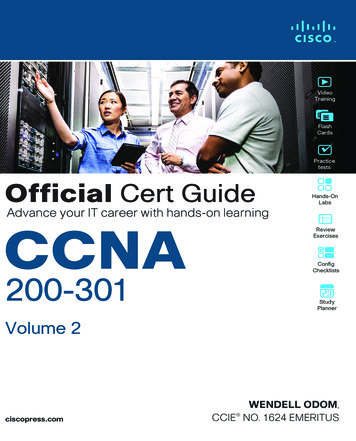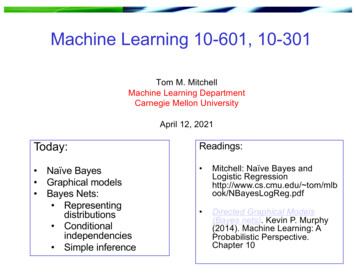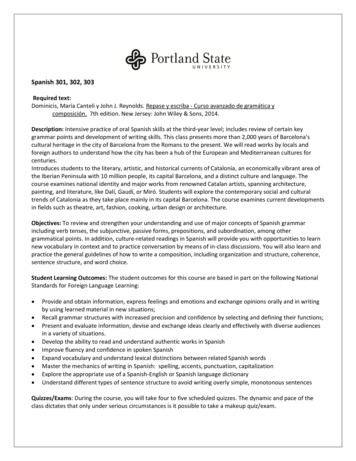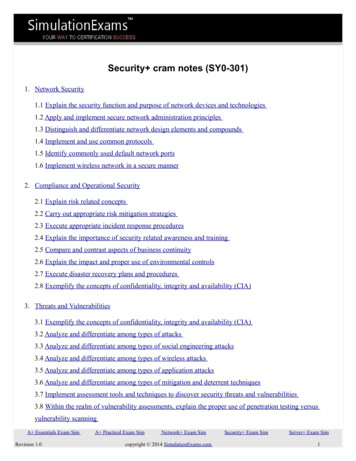
Transcription
Security cram notes (SY0-301)1. Network Security1.1 Explain the security function and purpose of network devices and technologies1.2 Apply and implement secure network administration principles1.3 Distinguish and differentiate network design elements and compounds1.4 Implement and use common protocols1.5 Identify commonly used default network ports1.6 Implement wireless network in a secure manner2. Compliance and Operational Security2.1 Explain risk related concepts2.2 Carry out appropriate risk mitigation strategies2.3 Execute appropriate incident response procedures2.4 Explain the importance of security related awareness and training2.5 Compare and contrast aspects of business continuity2.6 Explain the impact and proper use of environmental controls2.7 Execute disaster recovery plans and procedures2.8 Exemplify the concepts of confidentiality, integrity and availability (CIA)3. Threats and Vulnerabilities3.1 Exemplify the concepts of confidentiality, integrity and availability (CIA)3.2 Analyze and differentiate among types of attacks3.3 Analyze and differentiate among types of social engineering attacks3.4 Analyze and differentiate among types of wireless attacks3.5 Analyze and differentiate among types of application attacks3.6 Analyze and differentiate among types of mitigation and deterrent techniques3.7 Implement assessment tools and techniques to discover security threats and vulnerabilities3.8 Within the realm of vulnerability assessments, explain the proper use of penetration testing versusvulnerability scanningA Essentials Exam SimRevision 1.0A Practical Exam SimNetwork Exam Simcopyright 2014 SimulationExams.comSecurity Exam SimServer Exam Sim1
4. Application, Data and Host Security4.1 Explain the importance of application security4.2 Carry out appropriate procedures to establish host security4.3 Explain the importance of data security5. Access Control and Identity Management5.1 Explain the function and purpose of authentication services5.2 Explain the fundamental concepts and best practices related to authentication, authorization and accesscontrol5.3 Implement appropriate security controls when performing account management6. Cryptography6.1 Summarize general cryptography concepts6.2 Use and apply appropriate cryptographic tools and products6.3 Explain the core concepts of public key infrastructure6.4 Implement PKI, certificate management and associated componentsA Essentials Exam SimRevision 1.0A Practical Exam SimNetwork Exam Simcopyright 2014 SimulationExams.comSecurity Exam SimServer Exam Sim2
1. Network Security1.1 Explain the security function and purpose of network devices and technologiesFirewalls1. Firewalls protect against and filter out unwanted traffic. A firewall can be an individual device or can beadded to a router. For example, most SOHO routers have a firewall built in, and Cisco Integrated ServicesRouters include the Cisco IOS Firewall. Regular routers, and routers with firewall functionality, have theability to block certain kinds of traffic. For example, if the ICMP protocol has been blocked, then you wouldnot be able to ping the router.2. A personal firewall is software that resides on the end users computers. This is different from a regularfirewall, in the sense that a personal firewall is geared to protect a single user computer.3. The following are the basic types of firewall architectures: Bastion host Screened host gateway Screened subnet gateway or DMZHubA hub is basically a multi-port repeater. When it receives a packet, it repeats that packet out each port. Thismeans that all computers that are connected to the hub receive the packet whether it is intended for them ornot. It's then up to the computer to ignore the packet if it's not addressed to it. This might not seem like a bigdeal, but imagine transferring a 50 MB file across a hub. Every computer connected to the hub gets sent thatentire file (in essence) and has to ignore it.BridgeA bridge is a kind of repeater, but it has some intelligence. It learns the layer 2 (MAC) addresses of devicesconnected to it. This means that the bridge is smart enough to know when to forward packets across to thesegments that it connects. Bridges can be used to reduce the size of a collision domain or to connect networksof differing media/topologies, such as connecting an Ethernet network to a Token Ring network.SwitchA switch is essentially a multi-port bridge. The switch learns the MAC addresses of each computer connectedto each of its ports. So, when a switch receives a packet, it only forwards the packet out the port that isconnected to the destination MAC address. Remember that a hub sends the packet out every port.RouterA router works at the logical layer of the IP stack. It is basically required to route packets from one network(or subnet) to another network (or subnet). In the given question, all the computers are within the same subnetand a router is inappropriate.GatewayA Essentials Exam SimRevision 1.0A Practical Exam SimNetwork Exam Simcopyright 2014 SimulationExams.comSecurity Exam SimServer Exam Sim3
A gateway works at the top layers of the TCP/IP stack. For example, a Gateway may be used to facilitatecommunication between a Unix mail server and a Windows mail server.Load BalancerA load balancer is used to distribute workload across multiple computers or a computer cluster. It could bedone by a dedicated hardware or software.Proxiesproxies also called as proxy servers cache website information for the clients, reducing the amount of requeststhat need to be forwarded to the actual corresponding web server on the Internet. These save time, usebandwidth efficiently also help to secure the client connections.VPN ( Virtual Private Network)1. VPN is private network formed using public Internet. It is formed between two hosts using tunnelingprotocols such as PPTP, L2TP, etc. Using VPN, you can connect two LANs in geographically distantlocations together, as if they were located in the same building. The cost of connecting these LANs together issmall since public Internet is used for providing the WAN link.2. The VPN can be implemented in any of the following combinations:a. Gateway-to-gateway VPN: It is transparent to the end users.b. Gateway-to-host VPNc. Host-to-gateway VPNd. Host-to-host VPN :This configuration provides the highest security for the dataThe host-to-host configuration provides the highest security for the data. However, a Gate-to-GatewayVPN is transparent to the end users.3. VPN concentrators allow for secure encrypted remote access.4. Intranet: It is used by the employes within the organization.5. Extranet : The customers and vendors of the company use this for order processing,and inventory controlon-line.NIDS (Network Intrusion Detection System)It is a type of IDS (intrusion detection system) that Detects malicious network activities. It constantly monitorthe network traffic. A honeypot or honeynet is used to attract and trap potential attackers. Example Snort,NIPS (Network Intrusion Prevention System)It is designed to inspect traffic, and based on its configuration or security policy, it can remove, detain, orredirect malicious traffic. It removes, detains, or redirects malicious traffic. Example MacAfee Intrushield.Protocol Analyzer And Packet Analyzer (Sniffer)These are loaded on a computer and are controlled by the user in a GUI environment; they capture packetsenabling the user to analyze them and view their contents. Example Network MonitorSpam filtersSpam filters will help to filter out spam (unwanted e-mail). They can be configured in most e-mail programsor can be implemented as part of an anti-malware packageA Essentials Exam SimRevision 1.0A Practical Exam SimNetwork Exam Simcopyright 2014 SimulationExams.comSecurity Exam SimServer Exam Sim4
Network firewallsThese are also called as packet filters and these operate at low level of the TCP/IP stack. These do not allowpackets to pass through unless they meet some established set of rules.Application FirewallIt can control the traffic associated with specific applications. These work on the application layer of TCP/IPstack. These inspect each packet traveling to and from an application like browser, telnet and block them ifthey are improper according to set rules.URL FilteringURL filtering is used categorize the websites on the internet. You can allow/block specific website access to othe web users of the organization. This can be done by referring to central database or by classifying thewebsites in real time. URL filtering can also be made applicable only during certain times of a day or days ofa week, if required.Content inspectionContent inspection is the process in which user data is actively monitored for malicious elements, and badbehaviour according to configured policies before allowing or denying the content to pass through thegateway and enter into the network. This prevents any confidential data going outside the network.1.2 Apply and implement secure network administration principlesAll web applications such as Web servers, News servers, email servers etc. need to be configured as secure aspossible. This can be achieved by Removing all unnecessary services. These are the services that are installed but not used. For example,you might have installed TFTP, but not using it. It is better to remove the application or service that isnot used as it may provide an opportunity to a hacker to abuse the resource.Remove all unnecessary protocols: These are the protocols that are installed but not used. Forexample, you might have installed Novell Netware protocol but not necessary. It is preferable toremove that protocol.Enable server and application logs: The logs provide an opportunity to look into the activity on theserver over the past few hours or days. Check for any unusual activity such as failed login attemptsetc.Secure router configurationBefore a router is put on a network make sure you set a username and password for it. Also, the passwordshould be complex and difficult to crack. Make sure you check all default settings and change them accordingto requirement.Access control lists (ACLs)ACL resides on a router, firewalls or computers and decides who can access the network and who cannot.A Essentials Exam SimRevision 1.0A Practical Exam SimNetwork Exam Simcopyright 2014 SimulationExams.comSecurity Exam SimServer Exam Sim5
That means it enable or deny traffic. It specify which user or group of users are allowed what level of accesson which resource. It makes use of IP addresses and port numbers.Port SecurityIt deals more with switches and the restriction of MAC addresses that are allowed to access particularphysical ports.802.1XIt is an IEEE standard that is known as port-based Network Access Control (PNAC). It works on Data LinkLayer. It connect hosts to a LAN or WLAN. It also allows you to apply a security control that ties physicalports to end-device MAC addresses, and prevents additional devices from being connected to the network.Flood GuardsIt can be implemented on some firewalls and other devices. It tracks network traffic to identify scenarios suchas SYN, ping, port floods, etc. By reducing this tolerance, it is possible to reduce the likelihood of asuccessful DoS attack. If it looks that an resource is being overused, then the flood guard comes in to picture.Loop protectionTo avoid loops, many network administrators implement Spanning Tree Protocol in their switches. Loopprotection should be enabled on the switch to prevent the looping that can occur when a person connects bothends of a network cable to the same switchImplicit denyIt requires that all access is denied by default and access permissions are granted to specific resources onlywhen required. An implicit deny clause is implied at the end of each ACL, and it means that if the provisionin question has not been explicitly granted, then it is denied.Log AnalysisLog analysis is used to determine what happened at a specific time on a particular system.1.3 Distinguish and differentiate network design elements and compoundsDMZ (DeMilitalized Zone)It is a place separate from the LAN where servers reside that can be reached by users on the Internet. If acompany intends to host its own servers to be accessed from public Internet, a DMZ is most preferredsolution. The network segment within the DMZ is secured by two firewalls, one interfacing with the publicInternet, and the other interfacing the internal corporate network. Thus, a DMZ provides additional layer ofsecurity to internal corporate network. The type of servers that are hosted on DMZ may include web servers,email servers, file servers, DNS servers, etc.SubnettingIP addresses can be manipulated to logically create sub networks .Each of this sub network is a distinctportion of a single network. Some advantages are efficient use of IP address space, reducing collision andtraffic and increasing security.A Essentials Exam SimRevision 1.0A Practical Exam SimNetwork Exam Simcopyright 2014 SimulationExams.comSecurity Exam SimServer Exam Sim6
VLANJust like subnetting VLAN is used to logically segment a network or part of a network. Some advantages arebetter organization of network, reducing collision, increase in performance and security. This does not requireany change in physical location of the workstations. Users from different corner of the network like differentfloors in a building or even different buildings can belong to same VLAN as it is just logical segmentation.NAT (Network Address Translation)It is primarily used to hide internal network from external network, such as the Internet. A NAT basicallytranslates the internal IP addresses to external IP addresses and vice-versa. This functionality assures thatexternal users do not see the internal IP addresses, and hence the hosts.TelephonyIt is the collection of methods by which telephone sevices are provided to an organi
Security cram notes (SY0-301) 1. Network Security 1.1 Explain the security function and purpose of network devices and technologies 1.2 Apply and implement secure network administration principles 1.3 Distinguish and differentiate network design elements and
